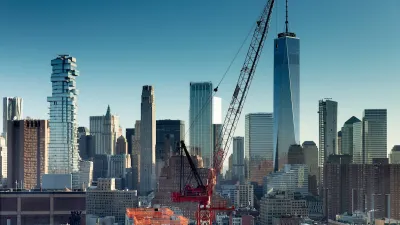The city’s ambitious ‘City of Yes’ zoning reform plan requires a broad array of sometimes controversial policy changes.

The Manhattan Institute’s Eric Kober examines New York City’s City of Yes for Housing Opportunity (COH) zoning reform proposal, which is being described as a ‘moonshot’ effort to significantly boost the city’s housing supply in a decade.
A half-million new housing units over a decade translates into 50,000 units each year, a level not reached since the early 1960s—and then, for only a few years.
Attempting to answer the question of what policies can help the city achieve its ambitious goal, Kober notes that enacting the CHO is just one piece of a larger puzzle, pointing out that zoning regulations in 1961 were far more attuned to the potential for rapid population growth and a surge in housing demand. Kober recommends “far more permissive” zoning that accommodates changing demand mirroring the 1961 policies, as well as “rational and consistent” taxation of residential properties, and rent control policies that are sensitive to their impacts on new construction.
However, “Many of these reforms represent daunting political hurdles, and change won’t happen quickly. An optimistic scenario is that NYC will see incremental reforms, and housing construction will creep up.” While the mayor’s goal of 500,000 new housing units may be out of reach, it provides an aspirational target that could move the needle on the city’s housing crisis.
FULL STORY: What Would New York City’s Housing “Moonshot” Look Like?

Planetizen Federal Action Tracker
A weekly monitor of how Trump’s orders and actions are impacting planners and planning in America.

Congressman Proposes Bill to Rename DC Metro “Trump Train”
The Make Autorail Great Again Act would withhold federal funding to the system until the Washington Metropolitan Area Transit Authority (WMATA), rebrands as the Washington Metropolitan Authority for Greater Access (WMAGA).

DARTSpace Platform Streamlines Dallas TOD Application Process
The Dallas transit agency hopes a shorter permitting timeline will boost transit-oriented development around rail stations.

Renters Now Outnumber Homeowners in Over 200 US Suburbs
High housing costs in city centers and the new-found flexibility offered by remote work are pushing more renters to suburban areas.

The Tiny, Adorable $7,000 Car Turning Japan Onto EVs
The single seat Mibot charges from a regular plug as quickly as an iPad, and is about half the price of an average EV.

Supreme Court Ruling in Pipeline Case Guts Federal Environmental Law
The decision limits the scope of a federal law that mandates extensive environmental impact reviews of energy, infrastructure, and transportation projects.
Urban Design for Planners 1: Software Tools
This six-course series explores essential urban design concepts using open source software and equips planners with the tools they need to participate fully in the urban design process.
Planning for Universal Design
Learn the tools for implementing Universal Design in planning regulations.
Municipality of Princeton
Roanoke Valley-Alleghany Regional Commission
City of Mt Shasta
City of Camden Redevelopment Agency
City of Astoria
Transportation Research & Education Center (TREC) at Portland State University
US High Speed Rail Association
City of Camden Redevelopment Agency
Municipality of Princeton (NJ)





























